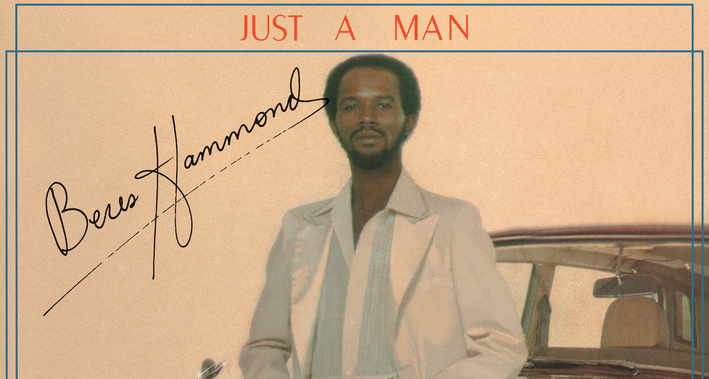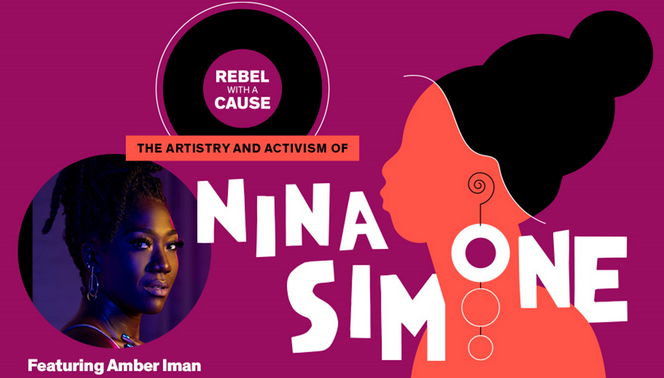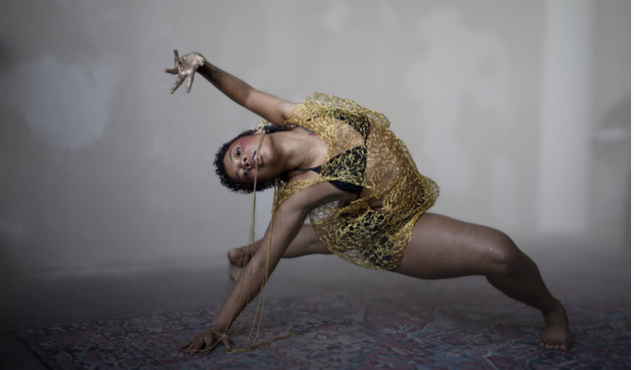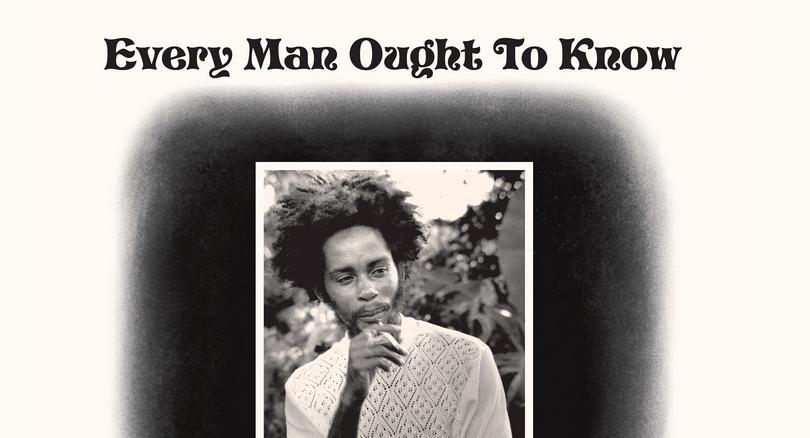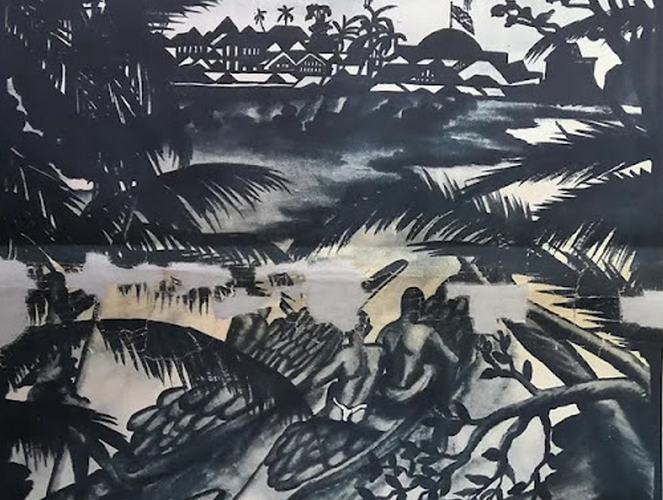Photos: Ishmael Reed\YouTube
Playwright Ishmael Reed (above left) uses satire to explore aspects of American culture and history overlooked by others. His newest play, “The Slave Who Loved Caviar: A Theatrical Investigation Into the Relationship Between Jean-Michel Basquiat and Andy Warhol,” challenges the notion that Basquiat was merely Warhol’s “mascot.”
Theater for the New City will present its world premiere December 23, 2021 to January 9, 2022, directed by Reed’s frequent collaborator, Carla Blank.
While Andy Warhol (1928-1987) is a household name, Jean-Michel Basquiat (1960-1988) is less commonly known outside the art world. His father was born in Haiti; his mother was born in Brooklyn to parents of Puerto Rican descent. Jean-Michel became a graffiti artist, pop icon, musician and neo-expressionist painter. He unified street art with painting, bridging modes that were historically considered high and low art. Warhol and Basquiat collaborated intensely in 1984 and 1985, with Warhol assuming an almost parental role in Basquiat’s life. Warhol’s studio assistant, Ronny Cutrone, remembered, “It was like some crazy-art world marriage and they were the odd couple. The relationship was symbiotic. Jean-Michel thought he needed Andy’s fame, and Andy thought he needed Jean-Michel’s new blood. Jean-Michel gave Andy a rebellious image again.”
Warhol died in 1987 and Basquiat, increasingly isolated, died of a heroin overdose in 1988. Now Basquiat is among the most highly valued artists in the art market, with works regularly selling for tens of millions at auction.
Struck by the one-sided commentary about the relationship between Warhol and Basquiat that is proffered by Warhol groupies and critics, Reed offers a different view in this play. Warhol worshipers claim that Basquiat was beholden to Warhol for his fame. Basquiat said that it was the other way around. Art dealer Bruno Bischofberger and others claim that Warhol’s reputation was on the decline when he began a collaboration with Basquiat, and it was Basquiat who re-invigorated Warhol, inspiring him to return to painting. Their relationship was a seductive personal and professional partnership, which Reed renders as a sort of artistic vampirism with Basquiat as the victim.
Warhol had a fascination with the legend of Count Dracula, which is why there is a cartoon-style running gag included in this play. It centers on a certain Baron De Whit, son of Dracula, whose Abstract style is passe as audiences insist that human figures re-enter the art scene. His agent recommends a plan to energize his sagging career by following Warhol’s example: find a young, vital, Black graffiti artist to be his collaborator. A youth they discover, a Basquiat imitator named Young Blood, fits the bill.
Of course, every vampire has a nemesis, and in this play, it is Chief of Detectives Mary Van Helsing. She is struck by the number of times that images of body fluids are invoked in the two artists’ relationship, and she engages two forensic experts to investigate the reasons for Basquiat’s death at the age of 27. As the forensic experts compare notes, an indictment of the Warhol set–and the art world at large–for the expropriation of Black artists takes shape before us. The accusation is that Warhol and his entourage killed Basquiat with intense production demands, dinner parties, drugs, and women. After they absorbed his vitality, they abandoned him, wanting only his “new blood.”
Similar charges reverberate through the autobiographical reflections of two other characters who walk through the play: Jack Brooks, a now-homeless Black abstractionist painter, and a Richard Pryor of the Dream, a character no doubt inspired by Reed’s friendship with the comedian dating back to the 60’s. They testify what it’s like for Black artists to “abandon the people and do that sterile European thing” and now to be “a fading anachronism.”
Reed also offers a classical metaphor to the relationship of Warhol and Basquiat, comparing the duo to the aging Emperor Hadrian and Antonius, the ancient world’s most beautiful boy. Reed writes, “As Basquiat, the Radiant Child of the downtown art scene of the 1980s, was sacrificed to sustain the dying career of a fading Super Star, Antonius was sacrificed so that Hadrian would recover from a mysterious illness.” Antonius, Reed says, was the superstar of the ancient world; Basquiat is the superstar of the 2000’s. After their deaths, everybody wanted a piece of them. Reed writes, “Like Basquiat of the 2000s, statues of Antonius appeared throughout the Empire. His face appeared on coins, and on plates. After his death, Basquiat’s image appeared on coffee cups, T-shirts, shoes, socks, canteens, shopping bags, etc.”
Nuyorican Poets Cafe hosted a reading of “The Slave Who Loved Caviar” last March which generated enthusiastic testimonials. Ron Scott, writing in the Amsterdam News, declared, “I loved the play reading…so funny…enjoyed every minute of it. The cast is remarkable. Bravo!” Poet and playwright Christopher Lonely called it “a tour de force mixing the essayistic and dramatic, campy B-movie melodrama with anti-racist art history.”
Ishmael Reed is author of twelve novels, nine collections of essays, fifteen anthologies of criticism and ten plays of which this is the latest. The New Yorker has labeled him “America’s most fearless satirist” and his exposés often attract bitter criticism. A firestorm of comments, often ferocious, appeared in The New York Times and Broadway World in response to his “The Haunting of Lin-Manuel Miranda” (Nuyorican Poets Cafe, 2019), which deconstructed the Broadway play’s abolitionist portrayal of the founding father with incisive, impeccably-researched satire. The play portrayed a naive, defensive Miranda awakening to the sins of the Founding Fathers. Writing in The New York Times, Elizabeth Vincentelli characterized it as “classic activist theater” and “a cross between ‘A Christmas Carol’ and a trial at The Hague’s International Criminal Court.”
Reed’s eighth play, “Life Among the Aryans” (Nuyorican Poets Cafe, 2018), envisioned a future when the downtrodden denizens of the Alt Right realize they’d be better off if they were Black. His latest anthology, “Bigotry on Broadway,” co-edited with Carla Blank, was published this fall by Baraka Books. His best-known novel, “Mumbo Jumbo” (1972), was cited by Harold Bloom as one of the 500 great books in the Western Canon.
His newest poetry collection, “Why the Black Hole Sings the Blues: Poems 2007-2020,” was released from Dalkey Archive Press in November 2020. He is also a publisher, songwriter, cartoonist, public media commentator, lecturer, teacher, and founder of the Before Columbus Foundation and PEN Oakland, non-profit organizations run by writers for writers.
Reed’s honors include a MacArthur Fellowship, nominations for a National Book Award and a Pulitzer Prize, a Lila Wallace-Reader’s Digest Award, the 2008 Blues Songwriter of the Year from the West Coast Blues Hall of Fame, San Francisco LitQuake’s 2011 Barbary Coast Award, the University of Buffalo’s 2014 Distinguished Alumni Award, and the 2017 AUDELCO Pioneer Award for the Theater. He was San Francisco’s first Jazz Poet Laureate from 2012-2016. He is also an accomplished pianist and songwriter; his tunes have been recorded by Gregory Porter, Cassandra Wilson, Macy Gray, Taj Mahal and Bobby Womack.
Reed taught for over 35 years at the University of California and was honored as their Emeritus Professor Awardee of the Year 2020. He is now a Distinguished Professor at California College of the Arts and also taught a Spring 2019 creative writing class at UC Berkeley. His online literary magazine, Konch, can be found at https://www.ishmaelreedpub.com/. His author’s website is www.ishmael reed.org.
Carla Blank is a director, dramaturge, writer and editor. From 2003-2012 she directed productions of Wajahat Ali’s “The Domestic Crusaders.” A collaboration with director Robert Wilson, “KOOL- Dancing in my Mind,” an homage for Japanese choreographer Suzushi Hanayagi, premiered at NYC’s Guggenheim Museum in April 2009. From 2003-2012 she directed productions of Wajahat Ali’s “The Domestic Crusaders.” She directed “News from Fukushima,” a multimedia performance work by Yuri Kageyama, at La MaMa in 2015 and Z Space in San Francisco in 2017. A documentary film of the 2017 performance is receiving international acclaim. She directed Ishmael Reed’s “Hubba City” in Xiangtan, China in 2016.
The actors are Jesse Bueno, Maurice Carlton, Raul Diaz, Roz Fox, Laura Robards, Monisha Shiva, Brian Simmons, Robert Turner, and Kenya Wilson, who with Daniel Lugo also serves as an understudy. Rome Neal, Director of the Nuyorican Poets Cafe, is Production Coordinator. Video production is by Zohair Zaidi. Set designer is Mark Marcante. Assistant Set Designer is Lytza Colon. Lighting Designer is Alexander Bartenieff. Costume Designer is Diana Adelman. Projection Designer is Miles Shebar. Original music is composed and performed by Ishmael Reed.
Ishmael Reed writes, “Carla Blank and I are very grateful for the warm welcome Crystal Field and her Theater for the New City staff have extended to us. This is the first time for our work to be presented under their storied umbrella, and we feel very lucky to become part of this forward-looking community.”





